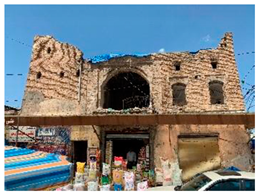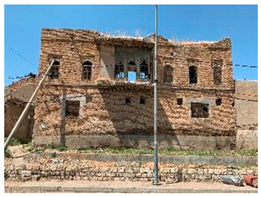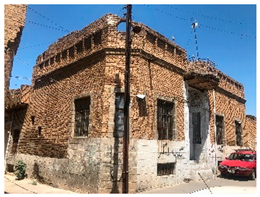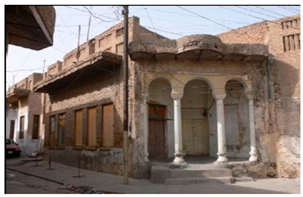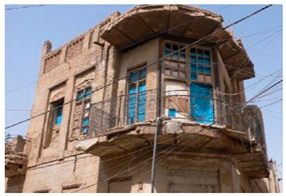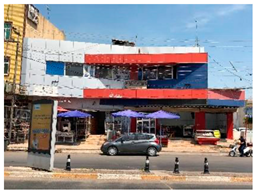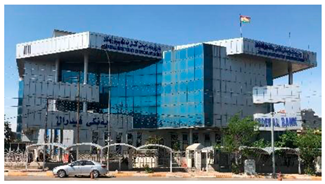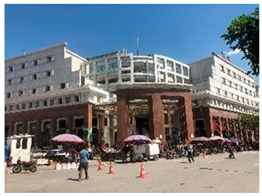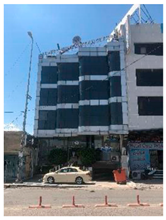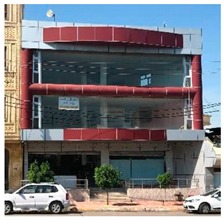Abstract
Community perceptions and experiences of built heritage are essential in understanding the built heritage and effect in individual and community wellbeing. Subsequently, local perceptions of built heritage directly influence the conservation and heritage-led interventions. This study investigated local perceptions of built heritage in Erbil by assessing responses of 414 participants using a questionnaire survey aiming to identify how built heritage is perceived by the various group samples, exploring local perceptions’ (in)consistencies. Significant differences were found between architects’ and non-architects’ perceptions and related wellbeing. As the groups attribute different values, the results suggest that heritage buildings do not contribute to the wellbeing of non-architects as much as to architects. A contradicting result was found between modern and heritage buildings. This study contributes to the notion of human-centrality of the built environment by assessing local perceptions of built heritage, that, when implemented in urban planning and heritage management, can contribute to the city’s socio-cultural sustainable development.
1. Introduction
The notion of built heritage is underlined by values which stand central to the concept of heritage [1]. Due to a greater emphasis on heritage-related values, perception holds a vital role within the heritage discipline [2]. This accommodates subjective determinations of heritage strongly influenced by individual and community views and preferences [3,4], which directly inform attitudes towards built heritage [5]. By shifting the focus to valuation and perception, built heritage conservation has evolved into a dynamic process [6,7,8], facilitating sustainable development, by contributing to one of the pillars of sustainable development, the socio-cultural dimension [9]. Built heritage, as part of cultural heritage, affects individual wellbeing [10,11]. Wellbeing was recently coined as heritage values on a balanced conservation approach, considering the social, psychological, and physical environment [12]. This conceptual broadening in heritage studies emphasizes the need for contextual heritage research on heritage management.
Various studies have been conducted on Erbil Citadel, before and after its UNESCO inscription in 2014. The number of studies conducted on the Citadel buffer-zone, which is considered local heritage, is considerably lower. Moreover, studies on local perceptions of heritage are scarce. While buffer-zones are key in conserving World Heritage integrity, research has found that the delimitation of a buffer-zone can vary enormously between the physical and perceived delimitation [13]. The government owns the Citadel, and it is therefore not suffering direct development pressures [14]. Nevertheless, the buffer-zone is bound by urban design guidelines (UDG) [15]. UNESCO raised concerns about the locations and designs of new (re)constructions [16]. While the UDG is intended to ensure future development that respects the Citadel’s visual integrity, ICOMOS noted that inappropriate constructions already have adverse effects [14]. According to UNESCO, the former inhabitants of Erbil Citadel and Erbil’s civil society are insufficiently involved in the revitalization process [17]. As such, ICOMOS recommended strengthening residents’ involvement and information and considered social revitalization as the main challenge, determining Erbil’s sustainable heritage conservation [14]. Hitherto, local insights and contributions are marginalized where an overbearing authorization overshadows inhabitants’ inputs [18]. The built heritage of Erbil has been neglected over the years [19]; as such, the built heritage barely influences the contemporary architecture of Erbil [20].
To date, local standpoints and how built heritage is perceived and experienced are yet to be investigated. Unveiling this contributes significantly to the development of the city, as both heritage and local communities are vital for sustainability. Thus, within the framework of a PhD thesis, the central objective is to assess local perceptions, whereas an interactive survey method raises communal awareness in search for stakeholders’ perceptual differences and similarities, comparing architects’ and non-architects’ perceptions. The findings reveal reflections on the local conservation approach, which, unlike earlier studies, also integrate the local community.
2. Perceiving Built Heritage and Wellbeing
The notion of built heritage relies utterly on perception, as “even if the actual item is not physically impressive, it is the peoples’ perceptions of monuments…that create the perceptions of something more than the usual, something monumental” [21]. Aesthetic sensory experiences positively influence wellbeing [22], and the significance of heritage can be found in the sensory experiences provided to society [23]. Architecture and urban areas perceived as beautiful indicate experiences that positively influence wellbeing [24]. Buildings with perceived aesthetic quality positively impact the individual [25,26] by increasing their wellbeing [27], while ugly buildings have harmful effects [28]. Investigating perceptions of the built-environment, traditional-style architectural environments are found to be statistically preferred over contemporary built-environments [29]. Visiting heritage is found to make statistically positive contributions to wellbeing and even affect wellbeing slightly more than participating in sports and arts [27]. Emotional attachment to built heritage benefits wellbeing [30,31]; this is demonstrated by a sense of pride and emotional connectedness relating to built heritage [32,33]. From the perspective of living heritage, where locals play a central role, the perception of wellbeing is empirically investigated and found to be closely linked to the socio-cultural values that are enhanced by the quality of the place, inducing a sense of comfort and safety on a physical and social level [34]. To Bahrdt (1971), this emotional connectedness is partially defined by the uniqueness and individuality of the environment; historic centers are a case in point [35,36]. Attachment is also considered an indication of the social values of heritage [37]. Rollero and De Piccoli (2010) proved empirically that high levels of emotional attachment are more critical than environmental quality for a positive evaluation. This attachment is predicted by individuals’ educational level and the presence of significant relationships with the environment [38].
Perceived authenticity value represents a substantial base for the values of built heritage [39,40,41,42]. The ICOMOS [40] Nara Charter on Authenticity magnifies the role of context in evaluating authenticity, acknowledging the flexibility of its criteria and proposing updated assessments of authenticity due to value changes, as the purpose of conservation is to maintain heritage authenticity [43]. Repeatedly, the concept of authenticity is linked to identity [44], as the built and architectural heritage is held to promote local identity. In the Krakow Charter [43], identity is regarded as a significant notion, justifying the multiplicity of attitudes towards heritage. The symbolic value, derived from meanings locally attributed to the built environment, plays a significant role in heritage, which the architectural education aids in increasing its awareness [45], with disregard to the use-value [23] that is related to present-day usability and may conflict with other heritage values [45]. To Lynch (1972), the image of time, based on the awareness of the past and the future, is crucial for individual wellbeing [46]. The creation of such images goes through perceptual filters determined by cultural factors [2]. According to Relph (1979), personal experiences and memories, the length of time spent, and awareness of historic significance are determinant factors of built environment perceptions [32]. Empirical research found the historic city to contribute to wellbeing of the resident by the sense of the city’s history, where this is perceived to positively affect the perceivers’ physical and mental peacefulness [47]. Moreover, perceptions oscillate relative to personal and cultural perspectives [48], are subjective in quality [49], and are contextualized plus culture-based [50]. Founded on cognitive judgements of satisfaction and affective appraisals, individual wellbeing is regularly defined by subjective evaluations [51]. This evaluation is self-reported, for this measurement assesses individuals’ perceptions in relation to environmental stimuli through surveys [52]. In the context of the built environment, wellbeing is determined by preference [53] and satisfaction [48,54], while those preferences vary according to the perceivers’ backgrounds [48,49].
3. Measuring Perception
Measuring perceptions and associated meanings to built environments was initially proposed in environmental psychology [55], named semantic differential scale (SDS), later adapted by many scholars interested in human–environment interactions. Russell and Pratt (1980) proposed and tested a theoretical structure of affective variables and concluded that the meanings attributed to environments by individuals are both perceptual and affective in structure [56]. Haynu (1997) measured the individuals’ experiences of neighborhoods by testing visual quality in comparison to affective appraisal variables in the dark [57], and later in daylight [58], and also the emotional effect of curvature in interior design was measured using SDS [59]. Zhang and Lin (2011) attempted to diminish the designer–user gap by investigating users’ visual perceptions [60]. Perovic and Kurtovic (2012) implemented the SDS in the context of public open spaces [61]. Sanoff (2016) found significant differences comparing two different styles of residential buildings [62]. Khayat and Khaznadar (2016) implemented the SDS in the context of Erbil city using a single case study method [63]; they focused on social aspects that may have caused the neglect of the traditional and vernacular heritage of Erbil by using a questionnaire survey. This study has a sample size of 17 architecture department staff members and concludes that Erbil’s built heritage is “not the core of interest”, because the respondents do not share a common standpoint. As this was a relatively short conference paper, it proposes future research to unveil other aspects of the local perception and enhance the local awareness of the built heritage. Negami et al. (2019) found the emotional perception of the urban environment to directly affect the respondents’’ wellbeing [64], the visual, auditory, and tactile perceptions are investigated employing SDS [65]. Although the SDS has been previously used in the context of heritage studies, it has not been used to investigate attributed heritage values.
SDS resembles bipolar opposite adjectives evaluating a visual stimulus in the furthermost cases due to their perceptual content founded in understanding, as visual perception maintains a dominant position in the human environment interaction [65]. The adjective variables differ according to the research purpose. Hence, they are categorized into three variables; the qualitative variables, describing the visual stimuli, the heritage-value variables, and third, the affective-evaluative variables, which describe evoked emotional responses and preferences (Table 1).

Table 1.
Perceptual variables in relation to wellbeing according to previous literature.
3.1. Hypothesis Development
Evaluation of the built environment is determined by individuals’ perceptions, shaped by cultural factors [48] and educational background [38], and depends on the positive qualities of the built environment [62]. However, the notion of heritage is not only determined by heritage quality, but also by perceptions of society [21]. Thus, the evaluation of built heritage is not dependent solely on qualitative variables but also on attributed heritage-value variables. Furthermore, if individuals perceive the built environment emotionally [24], and the affective-evaluative variables can make a significant contribution to the individual wellbeing [29], then it is expected that the heritage-value variables, as well as qualitative variables, affect affective-evaluative variables. Moreover, as scholars identify the significance of educational background (previous knowledge) for heritage perceptions [38], it is expected that the relationship between perceived qualitative variables and perceived heritage-value variables decreases with an increase in previous knowledge. In this study, the architectural education is taken as a determinant factor for previous knowledge [45,71]. The conceptual model for this study is presented in Figure 1. Hence, this empirical study tests the following hypotheses;

Figure 1.
Conceptual model.
Hypothesis (H1).
The qualitative variables have a positive effect on the affective-evaluative variables.
Hypothesis (H2).
The heritage-value variables have a positive effect on the affective-evaluative variables.
Hypothesis (H3).
Educational background significantly affects the perceptions of built heritage value; hence, H3, indicating the relation between qualitative variables and heritage-value variables, is different for both groups. An increase in H3 is expected for architects in the case of heritage buildings and a decrease in the case of contrasting buildings for the architects in comparison to the non-architects.
3.2. Case Study
The buffer-zone of Erbil Citadel is classified by heritage value [15], and based on this, two categories were selected (Table 2). Using a methodological guideline for multiple case selection [72], for each category, six cases were selected with 12 cases overall to increase result certainty. The participant was exposed to six images at once for each case, assuming they solve perceptual problems in a convergent manner, meaning when participants are exposed to multiple images, heterogeneity saturation occurs, leading to synthesis and cohesion of structures connecting a multiplicity of visual information [73].

Table 2.
Case study categories. Source: authors according to [15].
Selecting cases (Table 3) and locations (Figure 2) unaffected by their setting is essential, as participants’ comparative judgments can be influenced [62]. In the case of the buffer-zone, these aspects include; lavish greenery and landscaping, distinct fences that draw the perceivers’ attention, the difference in building setbacks, piping, and heating/cooling services that are installed on the building facades. Thus, for selection, façades had to be perceivable at eye-level from the roads/pats and be clear on photographs. Buildings set back with high fences and greenery, simple one-story shops with no architectural features, unfinished buildings, and decayed buildings without heritage value were excluded.

Table 3.
Selected cases. Source: authors.
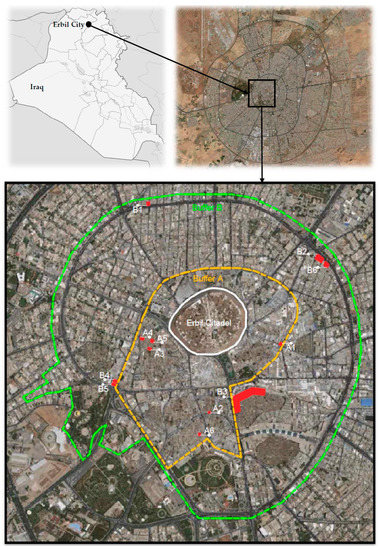
Figure 2.
Case locations. Image source: [74], adapted according to [15].
3.3. Participants and Procedure
A self-report method was applied [75], adopting an interactive face-to-face questionnaire (Appendix B). The participants were asked to give their opinions about the cases selected, from the buffer-zone of Erbil Citadel. To ease communication, the questionnaire was written in English and translated to Kurdish and Arabic. As the city population is approximately one million [76], a statistically significant sample size of (N = 400) is required, with a 5% margin of error. Personal information questions were followed by bipolar variables for each category (Table 1) based on a 5-point scale ranging from –2 to 2 with negative connotations to negative bipolar and vice versa, which means that for each variable, the participant could choose from the following responses (–2 resembling very negative, –1 resembling negative, 0 for neutral, 1 resembling positive, 2 resembling very positive). The purposive sampling method was used, where architects and design-related professions and non-architects were approached. This method can demonstrate how architectural education, which is, in Iraq, at least a five-year-long degree, during which students are taught about the values of heritage through subjects such as “history of architecture”, “vernacular architecture”, “conservation and rehabilitation”, and through contextual urban/architectural design projects. The participant selection took place across multiple locations in Erbil, both within and outside the buffer-zones. Many governmental institutions, such as the municipalities, governorates, board of investment, the ministry of construction and housing, the ministry of planning, and the ministry of municipality and tourism were visited to approach survey participants. In addition, major gathering points within the different neighborhoods were also included, aiming to cover Erbil city as a whole. The survey was conducted in 2020 in intermittent periods, due to the pandemic.
4. Discussion
A total of 417 questionnaire responses were gathered, including three inaccessible files. Reliability analyses indicated an acceptable level [77], as Cronbach’s alpha was (A—0.914, B—0.933). Personal information analysis showed that that the number of females (51%) and males (49%) was approximately equal. Participants’ ages ranged from 18 to 63 years, while their educational attainment was proportioned by 52.7% non-architects and 47.3% architects or similar design-related professions. The result analysis was conducted using IBM SPSS Statistics 25 by analyzing the mean, mean differences, correlation, and mode frequencies. The results generally support the main hypotheses that the educational background affects perceptions, confirming the previous literature [28,32,38]. The relations between the different variates are statistically positive; this supports the hypothesis that individual wellbeing is influenced not only by the environmental quality, but also the attributed heritage values [17,21,26,27,55].
4.1. High-Quality Heritage Buildings
Table 4 shows significant differences between the groups in line with the previous assumption that architectural education alters individual perceptions of heritage by raising awareness due to their wide range of knowledge [45], with the exception of the imaginative-unimaginative, useful-useless, valuable-worthless, stimulating-sedate variables. The non-architects associate this category with dirt, disruption, lack of safety, and they feel detached and unsatisfied. In comparison, architects recognize the monotonous and static character but find peace, attachment, and satisfaction in high-quality heritage buildings. Furthermore, this case category scores very low in qualitative variables for both groups, with different intensities. Furthermore, the architects evaluate heritage-values significantly higher than non-architects, and high-quality heritage buildings make a significant positive contribution to their wellbeing.

Table 4.
Mean comparison for A.
4.2. Contrasting Buildings
Contrasting buildings are perceived significantly differently (Table 5) to the preceding case category, where the results demonstrate opposite evaluations. Unlike the preceding case category, for the contrasting buildings, architects report a negative effect on wellbeing, while this effect is positive for non-architects, although both groups are both equally “happy” and “satisfied”, and “desire” and the qualitative variables also give no significant difference between the mean values. However, this category can be identarian and valuable to architects; they perceive the contrast buildings as “fake”, “uncomfortable”, and “distant”, and “dislike” them, and are “ashamed” of them. It is possible that the architects’ perceptions are affected by the location of these buildings in the buffer-zone in line with international concerns about this category [13,14,15]. Non-architects’ responses show they perceive this category as “common”, “imaginative”, “harmonious”, and “useful”, and “like” this case category.

Table 5.
Mean comparison for B.
4.3. Comparing Perceptions
The results Figure 3 demonstrate significant differences in perception between architects and non-architects. Such differences were previously detected in cultural heritage planning research between professionals and local residents [71,78]. Architects’ perceptions show higher differentiation, as high-quality heritage buildings score low in quality and high in heritage-values. In the case of affective-evaluative variables, non-architects’ wellbeing is more affected by contrasting buildings over the high-quality heritage, contradictory to architects. Despite this differentiation of architects’ perceptions, it is shown (Table 6) that the quality of heritage buildings is correlated to wellbeing. It is possible that a balance is required between the quality and the heritage values, as an imbalance may change the individual wellbeing [12], and the perception of heritage and wellbeing complement each other [34].
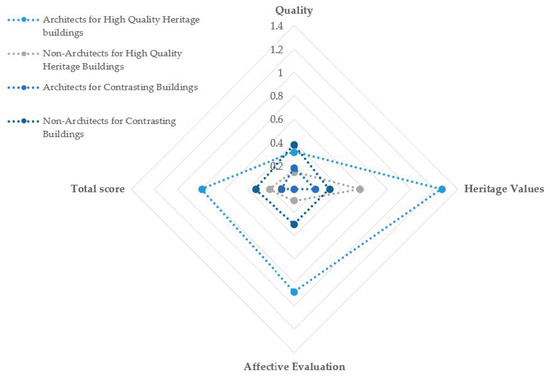
Figure 3.
Mean values.

Table 6.
Correlation coefficient differences.
Correlation coefficients (Table 6) demonstrate significant relations between qualitative variables and affective-evaluative variables for both categories, supporting H1. This is analogous for the heritage-value variables and affective-evaluative variables, supporting H2 subsequently. To test H3, the difference between the correlations was calculated, in which heritage-value variables were put against qualitative variables; differences were significantly higher for non-architects in the case of the high-quality heritage buildings. In the case of contrasting buildings, this difference is higher for the architects. The results indicate that architects’ perceptions of heritage are not as affected by qualitative characteristics compared to the non-architects. This is in support of H3, where educational backgrounds influence the perceptions of built heritage. Architects are educated about the value of the built heritage throughout their study, and therefore may be able to differentiate between the qualitative aspects of the built-environment and meanings and different attributed values. The results show that built heritage does not contribute to non-experts’ wellbeing as much as the contrasting buildings. This is in opposition to earlier research findings, such as [34,47]. However, this may be explained by the significant role that quality plays in the non-experts’ perceptions, given that heritage buildings were in a poor condition (Table 4, Table 5 and Table 6).
As in qualitative research, the triangulation method is endorsed in order to showcase other aspects of results by offering different perspectives. Another central tendency measure, the mode, is calculated for both groups in both case categories (Appendix A). The response frequency indicates that the non-architects lean towards neutrality, especially for the high-quality heritage buildings, where the mode for only seven variables is higher than zero. This occurrence may be interpreted in two ways; either that the non-architects are under-informed about the built environment to have formed an opinion, which may be linked to their educational background [45,70,78], or they are aware of the inconsideration of their opinions, which has been previously discussed by Jasim et al. (2020) [18]. The survey found that the architects’ perceptions of heritage can be regarded as consistent and positive; the variables are positively rated, except for complexity, stimulation, variance, and dynamism (–1). Architects associate the high-quality built heritage with harmony, interest, safety, identity, authenticity, symbolism, and a sense of pride. The heritage buildings are viewed as valuable and are liked by the architects.
For the contrasting buildings, the neutral responses are again dominant for the non-architects, and only for impressiveness, safety, rationality, satisfaction, identity, value, desirability, and attachment are their responses positive (1). For the architects, a variance of ratings is visible for the contrasting buildings; while they are found to be discordant, unimpressive, uninteresting, common, disruptive, distant, negative, dirty, uncomfortable, and indicate a sense of detachment, the majority of architects acknowledge the imaginativeness, variance, dynamism, order, pleasantness, safety, rationality, identity, symbolism, value, pride, and desirability. These results show how the architects’ perceptions of quality and their affective evaluations are linked in the case of contrasting buildings. This outcome is similar to previous findings of the arithmetic mean values. Furthermore, the results indicate that the perception of authenticity—which scores 0—may play a critical role in the architects’ attitudes towards the contrasting buildings. This is in agreement with the local [15] and global approaches to heritage-led interventions [39,40,41,42,43].
5. Conclusions and Recommendations
As one of the first studies of its kind, local perceptions of built heritage and its effects on wellbeing were now assessed together. Based on an interdisciplinary literature review, a conceptual model was proposed and tested through case studies. The results show that both built environmental qualities and heritage value contribute to wellbeing conditioned by knowledge and education, as architects (experts) are educated on the value of built heritage. It is demonstrated that the effect of qualitative variables on heritage value is significantly higher for non-experts than for experts, with non-experts being more driven by the qualities of the built environment. Therefore, the findings validate the critical role of previous knowledge; hence, if the built heritage is significant due to its socio-cultural, economic, and political value, then the critical point is to share this significance with the non-architects. Education increases the local awareness, enriches the heritage-led interventions, and ensures sustainable development of the area, as it is due to local input that the built heritage retains its value.
Furthermore, the results are implementable to the revitalization of Erbilian built heritage, as pivot points are addressed through the survey. The qualitative state of high-quality heritage buildings and their services needs to be improved to enhance the various stakeholders’ perceptions of local heritage; built heritage needs to be understood as usable, as all stakeholders agree on the heritage buildings’ under-usability. Concerning the contrasting buildings, one cannot overlook that architects and non-architects have been mutually engaged in the emergence of contrasting buildings in the buffer-zone, if not architects even more. To balance out the area’s inevitable development, one can recommend design regulations embracing a stronger relation between built heritage features and contemporary features while respecting the high-quality heritage buildings’ integrity. This is especially important as, in this study, some experts and many non-experts showed a tendency toward the modern style. As the buffer-zone does not abide by rigorous interventions, this balance is possible, unlike the Citadel, where modern interventions could affect its outstanding universal value even more.
Additionally, as the previous literature on environmental psychology and heritage studies emphasizes the significance of setting, the generalization of results is limited to socio-cultural contexts. Nevertheless, the proposed conceptual model suggesting relationships between built environment qualities attributed heritage value, and their effects on wellbeing apply to different contexts. As seen throughout this study, the educational background plays a pivotal role in the perception of built heritage. Thus, if the architectural education is influential for the Erbilian built heritage’s perceptions, are there detectable differences between academic and non-academic architects? Additionally, as there are a number of non-experts showing a positive perception of built heritage, what are the factors affecting the non-architects’ perceptions of heritage aside from their education? Moreover, what are the roles of the place, length of residency, and socio-economic situations in the perceptual process? Did the condition of the heritage buildings influence the negative results of the non-architects? In further research, participants may be given the option for discussion by implementing open questions; this method may unveil other perceptual factors that enrich contextual heritage research. The perceptions of various architectural features may also be investigated. It is also interesting to explore internally related variables using other statistical analyses, discovering patterns relating to built heritage and non-heritage, experts and non-experts, to inform sustainable development further.
Author Contributions
Conceptualization, H.H.J.S.; methodology, H.H.J.S., M.K. and M.M.; software, H.H.J.S.; formal analysis, H.H.J.S.; writing—original draft preparation, H.H.J.S.; writing—review and editing A.P.R. and H.H.J.S.; resources, M.M. and A.P.R.; supervision, M.K. and M.M. All authors have read and agreed to the published version of the manuscript.
Funding
This research received no external funding.
Informed Consent Statement
Informed consent was obtained from all subjects involved in the study.
Data Availability Statement
Not applicable.
Acknowledgments
Firstly, many thanks to architect and PhD candidate Binyad Khaznadar for translating the English terms to Kurdish. The authors would also thank all the anonymous participants who patiently dedicated their time to answering the questionnaires to the best of their ability. We would also like to thank the anonymous reviewers for their valuable comments.
Conflicts of Interest
The authors declare no conflict of interest.
Appendix A

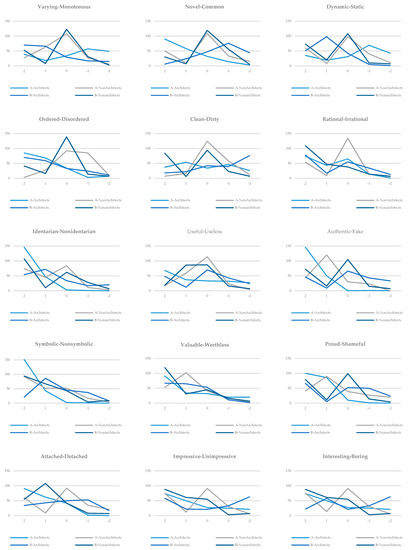
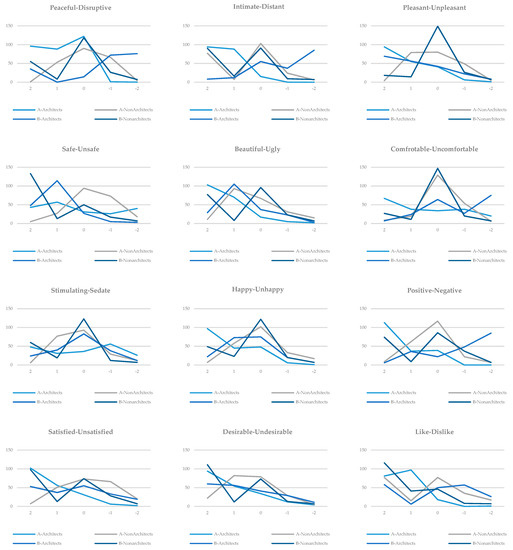
Figure A1.
Comparing the high-quality heritage buildings (A) and contrasting buildings (B) response frequencies.
Appendix B
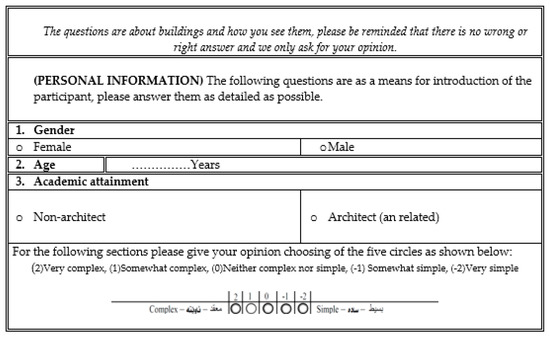
Figure A2.
Questionnaire form; Introduction and personal information.
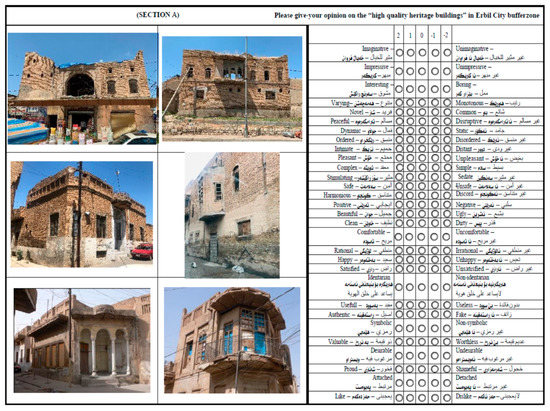
Figure A3.
Questionnaire form: high quality heritage buildings case category A.
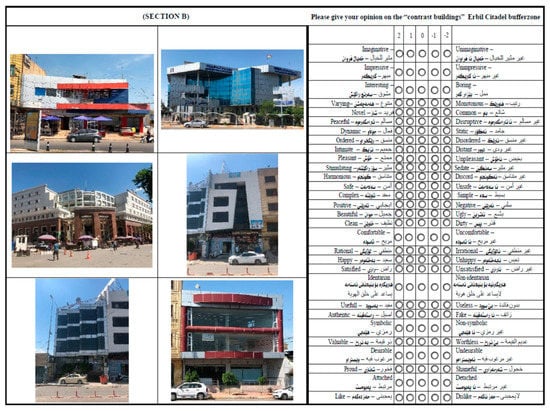
Figure A4.
Questionnaire form: high quality heritage buildings case category B.
References
- Pirkovic, J. Understanding the Convention into Challenging actions for Member States. In Heritage and Beyond; Council of Europe Publishing: Strasbourg Cedex, France, 2009; pp. 23–27. [Google Scholar]
- Fairclough, G. New Heritage Frontiers. In Heritage and Beyond; Council of Europe Publishing: Strasbourg, France, 2009; pp. 29–41. [Google Scholar]
- Vinas, S.M. Contemporary theory of conservation. Stud. Conserv. 2002, 47, 25–34. [Google Scholar] [CrossRef]
- Clark, K. The shift toward values in UK heritage practice. In Values in Heritage Management: Emerging Approaches and Research Directions; Avrami, E., Macdonald, S., Mason, R., Myers, D., Eds.; Getty Trust: Los Angeles, CA, USA, 2019; pp. 66–82. [Google Scholar]
- Serageldin, M. Preserving the historic urban fabric in a context of Fast-paced change. In Historic Cities: Issues in Urban Conservation; Cody, J., Siravo, F., Eds.; Getty Conservation Institute: Los Angeles, CA, USA, 2019; Volume 8, pp. 175–184. [Google Scholar]
- Matero, F. Preface. In Managing Change: Sustainable Approaches to the Conservation of the Built Environment 4th Annual US/ICOMOS International Symposium Organized by US/ICOMOS, the Graduate Program in Historic Preservation of the University of Pennsylvania, and the Getty Conse; Teutonico, J.M., Matero, F., Eds.; J. Paul Getty Trust: Philadelphia, PA, USA, 2001; pp. vii–viii. [Google Scholar]
- Fairclough, G. Cultural landscape, sustainability, and living with change? In Managing Change: Sustainable Approaches to the Conservation of the Built Environment 4th Annual US/ICOMOS International Symposium Organized by US/ICOMOS; Teuton-ico, J., Matero, F., Eds.; J. Paul Getty Trust: Philadelphia, PA, USA, 2001. [Google Scholar]
- Roders, A.P. Cultural heritage management: Power, values and identity. Antiquity 2014, 88, 1–4. [Google Scholar]
- Bazazzadeh, H.; Nadolny, A.; Attarian, K.; Najar, B.S.A.; Safaei, S.S.H. Promoting Sustainable Development of Cultural Assets by Improving Users’ Perception through Space Configuration; Case Study: The Industrial Heritage Site. Sustain. J. Rec. 2020, 12, 5109. [Google Scholar] [CrossRef]
- Napier, A.D. Cultural Contexts of Health and Well-Being Culture Matters: Using a Cultural Contexts of Health Approach to Enhance Policy-Making; World Health Organization: Geneva, Switzerland, 2017. [Google Scholar]
- WHO; UNESCO. Third Expert Group Meeting on Cultural Contexts of Health and Wellbeing; World Health Organization; Regional Office for Europe: Paris, France, 2017. [Google Scholar]
- Lawless, J.W. Finding human well-being in Historic Urban Landscapes. In The Routledge Handbook on Historic Urban Landscapes in the Asia-Pacific; Routledge: New York, NY, USA, 2019; pp. 313–325. [Google Scholar]
- Darabi, H.; Behbahani, H.I.; Shokoohi, S. Perceptual buffer zone: A potential of going beyond the definition of broader preservation areas. J. Cult. Heritage Manag. Sustain. Dev. 2020, 10, 271–291. [Google Scholar] [CrossRef]
- ICOMOS. Erbil Citadel (Republic of Iraq); ICOMOS: Paris, France, 2014. [Google Scholar]
- SPA. Planning and Building Regulations for the Buffer Zone of Erbil Citadel: UNESCO, HCECR, Erbil Governorate, Italy Easy Understandable Format; SPA: Erbil, Iraq, 2013. [Google Scholar]
- UNESCO. Convention Concerning the Protection of the World Cultural and Natural Heritage; World Heritage Committee; Forty Second Session’s Adopted Decisions; UNESCO: Manama, Bahrain, 2018. [Google Scholar]
- UNESCO. “Factors Affecting the Property,” Erbil Citadel. State of Conservation. 2019. Available online: https://whc.unesco.org/en/soc/3712 (accessed on 15 February 2021).
- Jasim, A.; Hanks, L.; Borsi, K. When Marginalising the Role of Local Participation in Heritage Conservation Policies: Evidence from Erbil Citadel. Athens J. Tour. 2020, 7, 17–40. [Google Scholar]
- Khayat, M.A.B.; Khaznadar, B.M.A. Erbil City’s Traditional and Vernacular Architecture Disastrous Status. ZANCO J. Pure Appl. Sci. 2016, 28, 429–436. [Google Scholar]
- Baper, S.Y. The Role of Heritage Buildings in Constructing the Continuity of Architectural Identity in Erbil City. Int. Trans. J. Eng. Manag. Appl. Sci. Technol. 2018, 9, 1–12. [Google Scholar]
- McFayden, L. Outer worlds inside. In Constructing Monuments, Perceiving Monumentality & The Economics of Building Theo-retical and Methodological Approaches to the Built Environment; Brysbaert, A., Klinkenberg, V., Garcia-M, A.G., Vikatu, I., Eds.; Sidestone Press: Leiden, The Netherlands, 2018; pp. 87–102. [Google Scholar]
- Bott, S.E. The measurement of meaning-Psychometrics and sense of place. In Human-Centered Built Environment Heritage Preservation; Theroy and Evidence-Based Practice; Wells, C.J., Stiefel, B.L., Eds.; Routledge: New York, NY, USA, 2019; pp. 45–66. [Google Scholar]
- Mason, R. Assessing the Values of Cul-tural Heritage. In Assessing Values in Conservation Planning: Methodological Issues and Choices; De La Torre, M., Ed.; The J. Paul Getty Trust: Los Angeles, CA, USA, 2002; pp. 5–30. [Google Scholar]
- Mallgrave, H.F. The Architect’s Brain: Neuroscience, Creativity and Architecture, 1st ed.; Wiley-Blackwell: Oxford, UK, 2010. [Google Scholar]
- Scannell, L.; Gifford, R. The experienced psychological benefits of place attachment. J. Environ. Psychol. 2017, 51, 256–269. [Google Scholar] [CrossRef]
- Moore, T.H.M.; Kesten, J.M.; López-López, J.A.; Ijaz, S.; McAleenan, A.; Richards, A.; Gray, S.; Savović, J.; Audrey, S. The effects of changes to the built environment on the mental health and well-being of adults: Sys-tematic review. Health Place 2018, 53, 237–257. [Google Scholar] [CrossRef]
- Fujiwara, D.; Cornwall, T.; Dolan, P. Heritage and Wellbeing; English Heritage: London, UK, 2014. [Google Scholar]
- Mouratidis, K. Rethinking how built environments influence subjective well-being: A new conceptual framework. J. Urban. Int. Res. Placemaking Urban Sustain. 2017, 11, 24–40. [Google Scholar] [CrossRef]
- Mouratidis, K.; Hassan, R. Contemporary versus traditional styles in architecture and public space: A virtual reality study with 360-degree videos. Cities 2020, 97, 102499. [Google Scholar] [CrossRef]
- Evans, G.W.; Kantrowitz, E.; Eshelman, P. Housing quality and psychological well-being among the elderly popula-tion. J. Gerontol. Psychol. Sci. 2002, 57, 381–383. [Google Scholar] [CrossRef] [PubMed]
- Auclair, E.; Fairclough, G. Theory and Practice in Heritage and Sustainability between Past and Future; Routledge Studies in Culture and Sustainable Development: New York, NY, USA, 2015. [Google Scholar]
- Power, A.; Smyth, K. Heritage, health and place: The legacies of local community-based heritage conservation on social wellbeing. Heal. Place 2016, 39, 160–167. [Google Scholar] [CrossRef] [PubMed]
- Chi, C.G.; Cai, R.; Li, Y. Factors influencing residents’ subjective well-being at World Heritage Sites. Touris 2017, 63, 209–222. [Google Scholar] [CrossRef]
- Rajapakse, A. Exploring the Living Heritage of Galle Fort: Residents’ Views on Heritage Values and Cultural Signifi-cance. J. Herit. Manag. 2018, 95–111. [Google Scholar] [CrossRef]
- Lalli, M. Urban-related identity: Theory, measurement, and empirical findings. J. Environ. Psychol. 1992, 12, 285–303. [Google Scholar] [CrossRef]
- Kaplan, S. Past environments and past stories in human effectiveness and wellbeing. In Changing Paradigms; Hardie, G., Moore, R., Sanoff, H., Eds.; School of Design, North Carolina State University: Oklahoma, OK, USA, 1989; pp. 223–228. [Google Scholar]
- Sjölm, J. Heritagisation, Re-Heritagisation and De-Heritagisation of Built Environments: The Urban Transformation of Kiruna, Sweden; Lulea University of Technology: Kiruna, Sweden, 2016. [Google Scholar]
- Rollero, C.; De Piccoli, N. Place attachment, identification and environment perception: An empirical study. J. Environ. Psychol. 2010, 30, 198–205. [Google Scholar] [CrossRef]
- ICOMOS. The Venice Charter 1964; ICOMOS: Venice, Italy, 1965. [Google Scholar]
- ICOMOS. The Nara Document on Authenticity (1994); ICOMOS: Nara, Japan, 1994. [Google Scholar]
- UNESCO. Vienna Memorandum; UNESCO: Vienna, Italy, 2005. [Google Scholar]
- UNESCO. The Hangzhou Declaration Placing Culture at the Heart of Sustainable Development Policies; UNESCO: Vienna, Italy, 2013; pp. 1–6. [Google Scholar]
- ICOMOS. The Charter of Krakow 2000: Principles for Conservation and Restoration of Built Heritage; Bureau Krakow: Krakow, Poland, 2000. [Google Scholar]
- Taher Tolou Del, M.; Sedghpour, B.S.; Tabrizi, S.K. The semantic conservation of architectural heritage: The missing values. Heritage Sci. 2020, 8, 1–13. [Google Scholar] [CrossRef]
- Jokilehto, J. A history of Architectural Conservation, 2nd ed.; Reed Elsevier: Kent, UK, 2002. [Google Scholar]
- Lynch, K. What Time Is This Place? 1st ed.; The MIT Press: Cambridge, MA, USA; London, UK, 1972. [Google Scholar]
- Silva, K. Mapping meaning in the city image: A case study of Kandy, Sri Lanka. J. Archit. Plan. Res. 2019, 28, 229–251. [Google Scholar]
- Gifford, R.; Steg, L.; Reser, J.P. Environmental Psychology. In IAAP Handbook of Applied Psychology; Blackwell Publishing: Oxford, UK, 2011; pp. 440–470. [Google Scholar] [CrossRef]
- Landry, C. The Art of City Making, 1st ed.; Earthscan: London, UK; Sterling VA, USA, 2006. [Google Scholar]
- Brysbaert, A. Constructing monuments, perceiving monumentality: Introduction. In Constructing Monuments, Perceiving Monumentality & The Economics of Building; Brysbaert, A., Klinkenberg, V., Garcia-M., A.G., Vikatu, I., Eds.; Side-Stone Press: Leiden, The Netherlands, 2018; pp. 21–47. [Google Scholar]
- Kesebir, D.; Diener, E. In Defence of Happiness: Why Policymakers Should Care about Subjective Well-Being. In Capa-bilities & Happiness, 1st ed.; Bruni, L., Comin, F., Pungo, M., Eds.; Oxford University Press: New York, NY, USA, 2008; pp. 60–80. [Google Scholar]
- Vigano, F.; Grossi, E.; Blessi, G.T. Well-Being in Alpine Space: How Subjective Determinants Determinants Affect Ur-ban and Rural Areas. A Case Study Analysis in South Tyrol, Italy. Urban Stud. Public Adm. 2018, 1. [Google Scholar] [CrossRef]
- Mourato, S.; Mazzanti, M. Economic Valuation of Cultural Heritage: Evidence and Prospects. In Assessing Values in COnservation Planning: Methoidological Issues and Choices; De La Torre, M., Ed.; The J. Paul Getty Trust: Los Angeles, CA, USA, 2002; pp. 51–76. [Google Scholar]
- Mouratidis, K. Built environment and social well-being: How does urban form affect social life and personal relation-ships? Cities 2018, 74, 7–20. [Google Scholar] [CrossRef]
- Osgood, C.E.; Suci, G.J.; Tannenbaum, P.H. The Measurement of Meaning; University of Illinois: Urbana, IL, USA, 1967. [Google Scholar]
- Russell, J.A.; Pratt, G. A Description of the Affective Quality Attributed to A Description of the Affective Quality At-tributed to Environments. J. Pers. Soc. Psychol. 1980, 38, 311–322. [Google Scholar] [CrossRef]
- Haynu, K. Visual properties and affective appraisals in residential areas after dark areas after dark. J. Environ. Psychol. 1997, 17, 301–315. [Google Scholar] [CrossRef]
- Hanyu, K. Visual Properties and Affective Appraisals in Residential Areas in Daylight. J. Environ. Psycl. 2000, 20, 273–284. [Google Scholar] [CrossRef]
- Nejad, K. Emotional Effect of Curvilinear Forms in Interior Design; Texas University: Austin, TX, USA, 2007. [Google Scholar]
- Zhang, H.; Lin, S. Affective appraisal of residents and visual elements in the neighborhood: A case study in an estab-lished suburban community. Landsc. Urban Plan. 2011, 101, 11–21. [Google Scholar] [CrossRef]
- Perovic, S.; Kurtovic, N. Visual Perception of Public Open Spaces in Niksic. Procedia Soc. Behav. Sci. 2012, 68, 921–933. [Google Scholar] [CrossRef][Green Version]
- Sanoff, H. Visual Research Methods in Design; Routledge: New York, NY, USA, 1991. [Google Scholar]
- Khayat, M.A.B. Formal characteristics of vernacular architecture in Erbil city and other Iraqi cities. Iraq J. Archit. Plan. 1997, 21. [Google Scholar] [CrossRef]
- Negami, H.R.; Mazumder, R.; Reardon, M.; Ellard, C.G. Field analysis of psychological effects of urban design: A case study in Vancouver. Cities Health 2019, 6, 1–10. [Google Scholar] [CrossRef]
- Perović, S.K.; Šestović, J.B. Creative Street Regeneration in the Context of Socio-Spatial Sustainability: A Case Study of a Traditional City Centre in Podgorica, Montenegro. Sustain. J. Rec. 2019, 11, 5989. [Google Scholar] [CrossRef]
- Hong, J.Y. Jeon, J.Y. Landscape and Urban Planning Influence of urban contexts on soundscape perceptions: A struc-tural equation modeling approach. Landsc. Urban Plan. 2015, 141, 78–87. [Google Scholar] [CrossRef]
- UNESCO. Recommendation on the Historic Urban Landscape; ICOMOS: Paris, France, 2011. [Google Scholar]
- Silva, A.T.; Roders, A.P. Cultural Heritage Management and Heritage (Impact) Assessments. In Proceedings of the Joint CIB W070, W092 & TG72 International Conference on Facilities Management, Procurement Systems and Public Private, Partnership, Cape Town, South Africa, 3–6 March 2012. [Google Scholar]
- Ibrahim, R.; Sabah, M.; Abdelmonem, M.G. Authenticity, Identity and sustainability in post-war Iraq. J. Islam. Archit. 2014, 3, 58–68. [Google Scholar] [CrossRef]
- Almukhtar, A. Place-identity in historic cities; The case of post-war urban reconstruction in Erbil, Iraq. In Urban Heritage along the Silk Roads; A Contemporary Reading of Urban Transformation of Historic Cities in the Middle East and Beyond; Arefian, F.F., Hossein, S., Moeini, I., Eds.; Springer Nature: Cham, Switzerland, 2020; pp. 121–136. [Google Scholar]
- Rapoport, A. The Meaning of the Built Environment; The University of Arizona Press; Beverly Hills; Sage Publications: Thousand Oaks, CA, USA, 1990. [Google Scholar]
- Shakir, M. The selection of case studies: Strategies and their applications to IS case studies. Res. Lett. Inf. Math. Sci. 2002, 3, 191–198. [Google Scholar]
- Bonaiuto, P.; Giannini, A.M.; Biasi, V. Perception theories and the environmental experience. In Psychological Theories for Environmental Issues; Bonnes, M., Lee, T., Bonaiuto, M., Eds.; Ashgate: London, UK, 2003; pp. 95–136. [Google Scholar]
- Satellite Map. 2021. Available online: https://satellites.pro/Iraq_map#36.183331,44.011930,15 (accessed on 1 February 2021).
- Farbstein, J.; Wener, R.E.; McCunn, L.J. Planning the built environment. In Research Methods for Environmental Psychology; Gifford, R., Ed.; Wiley-Balckwell: Pondicherry, India, 2016; pp. 221–247. [Google Scholar]
- Erbil Population. 2020. Available online: https://www.citypopulation.de/en/iraq/admin/arbīl/1701__arbīl/ (accessed on 18 January 2020).
- Trobia, A. Cronbach’s Alpha. In Encyclopedia of Survey Research Methods; Paul, J.L., Ed.; SAGE Publications: Los Angeles, CA, USA, 2008; Volume 1–2, pp. 168–169. [Google Scholar]
- Yang, H.; Qiu, L.; Fu, X. Toward Cultural Heritage Sustainability through Participatory Planning Based on Investigation of the Value Perceptions and Preservation Attitudes: Qing Mu Chuan, China. Sustain. J. Rec. 2021, 13, 1171. [Google Scholar] [CrossRef]
Publisher’s Note: MDPI stays neutral with regard to jurisdictional claims in published maps and institutional affiliations. |
© 2021 by the authors. Licensee MDPI, Basel, Switzerland. This article is an open access article distributed under the terms and conditions of the Creative Commons Attribution (CC BY) license (http://creativecommons.org/licenses/by/4.0/).
